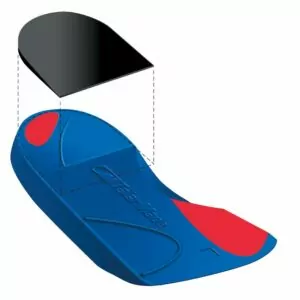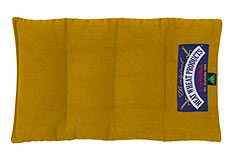Achilles Tendon Rupture
Updated:
(Also known as a Ruptured Achilles Tendon, Completely Torn Achilles Tendon)
What is an Achilles tendon rupture?
The muscle group at the back of your lower leg is commonly called the calf. The calf comprises of 2 major muscles one of which originates from above the knee joint (gastrocnemius) the other of which originates from below the knee joint (soleus). Both of these muscles then insert into the heel bone via the Achilles tendon (figure 1).

During contraction of the calf, tension is placed through the Achilles tendon. When this tension is excessive due to too much force, the Achilles tendon can be torn. Tears to the Achilles tendon can range from a small partial tear whereby there is minimal pain and minimal loss of function, to a complete rupture which may require surgical reconstruction.
Cause of an Achilles tendon rupture
Achilles tendon ruptures most commonly occur in patients in their 30’s or 40’s and typically occur when a patient attempts to accelerate from a stationary position or when lunging forwards such as while playing tennis or squash.
Signs and symptoms of an Achilles tendon rupture
An Achilles tendon rupture often presents as a severe sudden pain in the Achilles region, accompanied by an inability to bear weight on the injured leg. Patients often describe an audible ‘snap’ or ‘tear’ sound, or the sensation of being kicked or hit in the back of the leg at the time of injury.
Diagnosis of an Achilles tendon rupture
A thorough subjective and objective examination from a physiotherapist may be all that is necessary to diagnose an Achilles tendon rupture. Diagnosis may be confirmed with an MRI scan or ultrasound investigation.
Treatment for an Achilles tendon rupture
Treatment for a completely ruptured Achilles tendon is controversial and dependent on the age and requirements of the patient. Surgical repair of the Achilles tendon is generally considered the most appropriate form of management for active individuals seeking the highest level of function. This often involves a period of immobilization in a plaster cast for one to two months following surgery and a rehabilitation period of three to six months involving extensive physiotherapy.
Conservative management of Achilles tendon ruptures may be appropriate for older individuals. This involves immobilizing the Achilles tendon in a shortened position in a cast for approximately four weeks. The Achilles tendon is then gradually stretched and strengthened over time.
It is vital that all patients with a potential Achilles tendon rupture seek physiotherapy or medical assessment as soon as possible to determine if their Achilles tendon is ruptured. This is vital as delayed treatment may result in a poor outcome due to shortening of the torn Achilles and calf. The patient’s doctor or physiotherapist may then refer on to an orthopedic specialist if it is warranted clinically.
Contributing factors to the development of an Achilles tendon rupture
There are several factors which can predispose patients to developing this condition . These need to be assessed and corrected with direction from your physiotherapist. Some of these factors include:
- poor flexibility
- inappropriate training
- poor biomechanics
- poor foot posture
- inadequate warm up
- muscle weakness
- inadequate rehabilitation following a previous ankle, calf or achilles tendon injury
Physiotherapy for an Achilles tendon rupture
Physiotherapy treatment is vital to hasten the healing process, reduce the likelihood of recurrence and ensure an optimal outcome in all patients with this condition (whether managed conservatively or surgically). Treatment may comprise:
- soft tissue massage
- electrotherapy (e.g. ultrasound)
- anti-inflammatory advice
- the use of crutches
- the use of heel wedges
- stretches
- joint mobilization
- ice or heat treatment
- exercises to improve strength, flexibility or balance
- education
- activity modification advice
- biomechanical correction
- a gradual return to activity program
Exercises for an Achilles tendon rupture
The following exercises are commonly prescribed to patients with an Achilles tendon rupture following surgical repair or plaster cast immobilisation. You should discuss the suitability and timing of these exercises with your physiotherapist prior to beginning them. Generally, they should only be performed following surgical repair of the achilles tendon or plaster cast immobilisation and when the treating physiotherapist has indicated it is safe and appropriate to perform them. Generally they should be performed 1 – 3 times daily and only provided they do not cause or increase symptoms.
Foot and Ankle Up and Down
Move your foot and ankle up and down as far as possible and comfortable without pain (figure 2). Repeat 10 – 20 times provided there is no increase in symptoms.
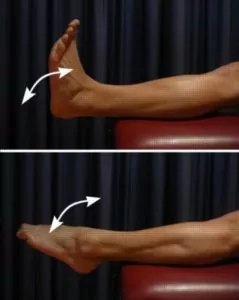
Foot and Ankle In and Out
Move your foot and ankle in and out as far as possible and comfortable without pain (figure 3). Repeat 10 – 20 times provided there is no increase in symptoms.
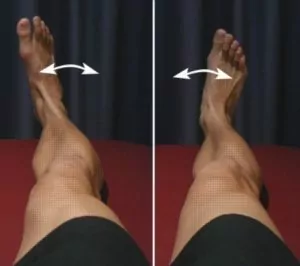
Ankle plantarflexion vs. resistance band
Begin this exercise with a resistance band around your foot as demonstrated and your foot and ankle held up towards your head (figure 4). Slowly move your foot and ankle down against the resistance band as far as possible and comfortable without pain. Repeat 10 – 20 times.

Lunge Stretch
Begin this exercise with your hands against the wall. Place the leg to be stretched in front of you as demonstrated. Keep your heel down. Gently move your knee forward over your toes until you feel a mild stretch in the back of your calf or Achilles tendon (figure 5). Hold for 15 seconds and repeat 4 times at a mild to moderate stretch provided there is no increase in symptoms.
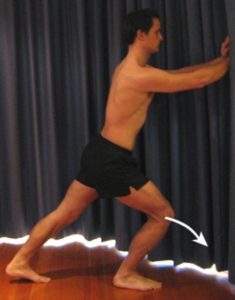
 Find a Physio for an Achilles tendon rupture
Find a Physio for an Achilles tendon rupture
Find a physiotherapist in your local area who can treat a ruptured achilles tendon.
 More Information for an Achilles tendon rupture
More Information for an Achilles tendon rupture
- View more Calf Flexibility Exercises.
- View more Calf Strengthening Exercises.
- View our Achilles & Heel Diagnosis Guide.
 Physiotherapy products for an Achilles tendon rupture
Physiotherapy products for an Achilles tendon rupture
Some of the most commonly recommended products by physiotherapists for patients with a ruptured achilles tendon include:
To purchase physiotherapy products for an Achilles tendon rupture click on one of the above links or visit the PhysioAdvisor Shop.

Link to this Page
If you would like to link to this article on your website, simply copy the code below and add it to your page:
<a href="https://physioadvisor.com.au/injuries/achilles-heel/achilles-tendon-rupture”>Achilles Tendon Rupture – PhysioAdvisor.com</a><br/>PhysioAdvisor offers expert physiotherapy advice and information on an Achilles Tendon Rupture including sign & symptoms, diagnosis, treatment, prognosis and more.
Return to the top of Achilles Tendon Rupture.

